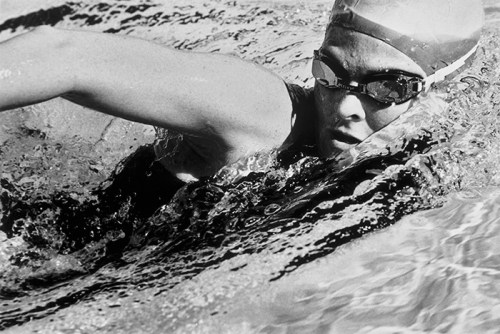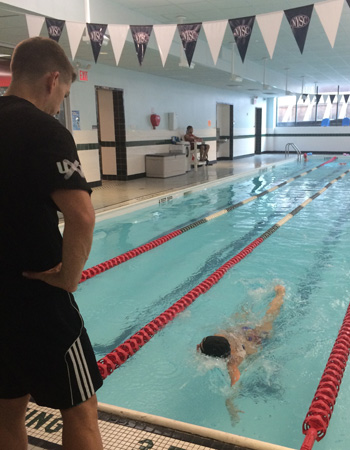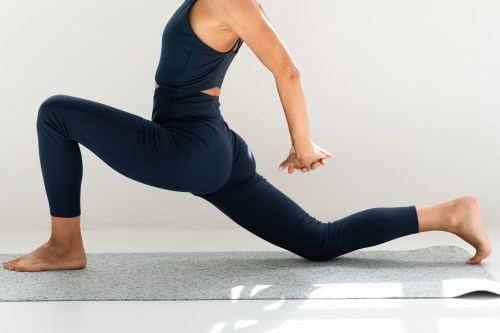
If you’re considering signing up for your first triathlon, you may have uttered this phrase: “I would totally do it. If it weren’t for the swimming…” Because while running and cycling feel pretty straightforward, swimming can feel like jumping into seriously uncharted—and intimidating—waters.
“You can get better at running or cycling by just getting out there and doing it, picking up tips here and there,” says New York Sports Club master trainer and triathlon coach Ken Szekretar. “But because swimming is so technique-oriented and the resistance of water is about almost 1,000 times that of air, any imperfections in your form are going to be the number one thing slowing you down.” (We suspected something as much.)
More Reading:Triathlon training for every level
To help you conquer your fears and make it to that first tri starting line, we hopped in the water with Szekretar for a one-on-one swimming session filled with tips and drills you can use. (And yes, you can still use them if triathlons sound crazy and you just feel like getting your workout on in the pool on 90-degree August days.)
More Reading:At this New York City spin studio, the bikes are in a pool
What my swim lesson was like:
To teach proper form, Szekretar starts by having his clients swim a few lengths of the pool so he can take a critical look at where you stand. “Then I can assign specific drills to work on the parts of the stroke that need improvement,” he says. The distance of the race (a sprint vs. a full Ironman) can change the exact workouts he assigns, but all usually include a warm-up, drill work, and a main set of either speed or endurance work.
In my 45-minute lesson, I learned that my childhood swimming lessons give me a slight leg up (thanks mom and dad!), but knowing how to effectively get to the other end of the pool is hardly enough to prepare you for a race. It’s the little things, like breathing to both sides without choking on water, using all your muscles so you don’t crap out after five minutes, and swimming in a straight line that make all the difference on race day.
While Szekretar recommends new swimmers take at least one lesson to avoid solidifying bad habits, you can also start a little technique work on your own.
Try these three simple drills to lay down essential swimming basics:
1. Skate Drill–for proper breathing technique

Swim the length of the pool with one arm straight out in front of you, about 6 inches beneath the surface of the water, and your head facing the bottom of the pool. Kick to move your body forward—your front arm should stay straight out, and your other, down by your side. When it’s time to breathe, turn your head to the side, inhale, then put your face back down in the water and exhale. Switch sides on your way back.
“Because you’re only using your kick to propel you, it should take a little bit longer and it might be a little more tiring,” Szekretar says. Engage your core, which will help you float and move forward a bit, and avoid over-rotating your body as you turn your head, as that will cause you to veer off course.
2. Zipper Switch–for good form
Start in the same position as the Skate Drill. Now, when you turn to breathe, bring the arm by your side up and out, and as you drive it back in, pull the other one back to your side, switching arms, and exhaling back down into the water. Repeat the breath and arm movement on the opposite side. It’ll feel like you’re swimming freestyle in slow-mo, but being deliberate and mechanical is important to finesse each component before putting it all together. “Slow will lead to good form, and good form will lead to being faster, so you’ll be faster while expending less energy, which for a triathlon, is the goal.” (It’s long, guys.)
“This is the foundation for bilateral breathing, which can really help facilitate swimming in a straight line,” Szekretar adds. It’s also key for being totally adaptable on race day, whether there are competitors swimming and splashing on the side you typically breathe on, the surf is coming in on that side, or there’s a glare off the water.
3. Fingertip Drag—for arm technique
We learned from the Zipper Switch that I bring my arm up too high, expending too much energy, and I don’t use my abs and back muscles like I should. So, next up was this arm technique drill.
“Once the elbow’s out of the water, think of dragging your fingertips across the surface and then bringing them down,” explains Szekretar. “You don’t want to bring it straight on like a windmill. That’s very laborious and expends a lot of energy.” Pretend a string is pulling your arm out of the water at your elbow, he explains, and keep the arm bent enough that you can maintain that drag along the water’s surface. Then push out into the front (your shoulder will naturally move toward the side of your head and your body will roll) and pull with your back and through the hip, keeping your hands in line with your shoulders.—Amy Marturana
For more information, visit www.mysportsclubs.com
Sign Up for Our Daily Newsletter
Get all the latest in wellness, trends, food, fitness, beauty, and more delivered right to your inbox.
Got it, you've been added to our email list.










